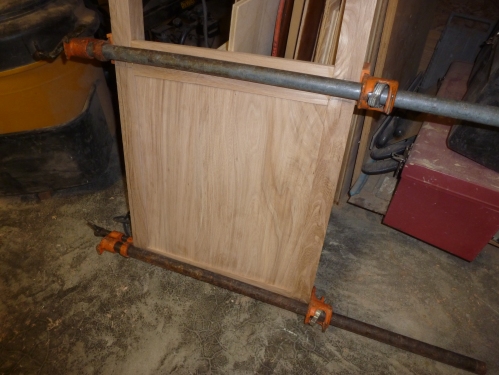
When the new Bloomingfoods grocery store in Bloomington’s Elm Heights neighborhood opens for business, its visual character will reflect contributions by local designers, builders, and artisans. One of these items will be Hoosier 2013, a custom-made endcap designed to display seasonal wares.
I was delighted to have the opportunity to work on an integral feature of this exciting new store. After detailed discussion with Bloomingfoods General Manager George Huntington and Systems and Planning Coordinator Jenn Hileman, I built the cabinet primarily from solid elm salvaged by the City of Bloomington’s Urban Lumber Recovery Program.
Elm for Elm Heights*
The elm tree grew near the present location of the city’s Animal Shelter. When the site was cleared for new construction, the tree was felled, then sawn and kiln dried by Robert Woodling. In 2009 I used half of the elm to build a Hoosier cabinet that marked the publication of my book The Hoosier Cabinet in Kitchen History. I used the rest to build this cabinet for Bloomingfoods.
The following series of pictures charts the process of turning some decidedly rough boards into a finished cabinet.

- Beetle tracks are still visible on the wany edge from below the bark. (The edge looks angled but is actually showing a small section of the circumference of the log. This phenomenon is called “wane” because it appears to be falling off, or getting smaller; think of how the moon waxes [from the German wachsen, to grow] and wanes.)

- A couple of really rough boards to be sawn for small parts

- Boards after surfacing, thicknessing, and edging

- When I purchase lumber from a commercial supplier I can order different thicknesses, but in this case the entire log had been sawn to a single thickness. To get the necessary thickness for the base cabinet legs I had to laminate the stock.

- One of the base cabinet’s sides, upside down in clamps. The top and bottom rails are tenoned into the legs, and the solid elm panel floats in a groove, allowing it to expand and contract with changes in humidity.
About the joinery and other details
I made the cabinet primarily using traditional joinery, though many original Hoosier cabinets would have been made using more production-oriented techniques.

The drawers, made of locally grown maple (some of it decidedly sub-par by conventional lumber standards, though fine for the display and educational purposes of this cabinet), are dovetailed and slide on traditional wooden runners with kickers to prevent tipping when opened.

A handcut mortise and tenon joint on a beaded frame. Although the Hoosier cabinet’s doors do not have beaded frames, they are constructed with the same basic type of mortise and tenon joinery as this example.
Because this Hoosier was designed to work as a grocery store endcap, I had to make some modifications to the traditional Hoosier cabinet model. The proportions are taller and skinnier than most originals. The pull-out cutting board in the base is just for show. The section above the counter is open, whereas an original Hoosier would have had doors or a tambour “curtain” to hide the contents. There is also a pair of doors in the base cabinet where an original Hoosier would have had only one wide door, typically with a built-in rack for storing lids of pots and pans; a single door would have protruded too far into the aisle.
Despite these modifications, the cabinet includes many distinctive Hoosier features such as the radiused front legs, wooden wheels, the curved top of the upper section, and the beveled half-overlay doors. The drawers slide on traditional wooden runners, just like those in the original Napanee cabinet from which I adapted this design; the small wire rack on the upper left door came from a vintage Hoosier cabinet; and the hardware on doors and drawers is reproduced from original early-20th-century examples.
The finish involved a multi-step process applied entirely by hand and is designed to resemble the “golden” finishes used on many early twentieth century Hoosier cabinets.
Of Local Interest
I purchased as many of the materials as possible from local vendors, in keeping with Bloomingfoods’ principles. Sundry hardware came from Kleindorfer’s Hardware and Variety Store on Kirkwood Avenue.
Bloomington Paint and Wallpaper was my source for the low-sheen enamel for most of the cabinet’s interior.
The Engraving and Stamp Center at West Seventh and Madison made the name plaque, and Bybee cut the limestone counter top, which I finished with paste wax.
The reproduction hinges, pulls, and latches came from Kennedy Hardware.
A few words about the economics of local lumber
Many people imagine that locally produced lumber costs a fraction of the price of commercial lumber. They are mistaken–at least in many cases where the lumber is for professional use. While the raw material itself may cost less, far more labor is required to turn irregularly shaped, green pieces of a tree into the relatively uniform lumber needed for making furniture based on straight lines and square edges.
When a furniture maker buys from a large commercial lumber company, boards have already been sawn, kiln dried, and graded in a process that is highly mechanized and efficient. This ensures a basic level of consistency in quality and dimensions that greatly reduces the amount of milling that needs to be done at the furniture maker’s shop. For example, when I purchase a load of cherry from my regular supplier, Frank Miller Lumber, the boards I receive are roughsawn (i.e., they are rough from the saw and still need to be surface planed to straighten one face, then thickness planed to whichever thickness I require), but they are basically uniform in thickness and have parallel edges.**
In contrast, when I buy locally, I am usually buying what amounts to kiln-dried slices of a debarked tree, with the majority of the log’s knots, splits, and other characteristics that are generally considered defects still in place. Cutting around these elements and turning the boards into usable lumber takes significant labor, which–at least for those of us who make our livelihood through woodworking–costs money.
In the big picture, however–with lumber, as with other “local” products, including food–buying locally helps to provide employment in the local economy while decreasing the distances over which products must be driven to market. It also allows customers to become acquainted with makers and see for themselves the circumstances in which their furniture, vegetables, clothing, etc. are made, instead of having to rely on greenwashing and other sometimes-misleading claims about employment practices. For more information about the benefits of buying locally, see http://www.localfirstindiana.org/.
*I owe this observation to my friend Mary Beth Roska.
**Frank Miller Lumber will also sell lumber surfaced and squared on four sides upon request, but some woodworkers prefer to do the final milling ourselves, so that we can have maximum control over the quality.










I am in awe of your talent and craftsmanship and dedication to green and local. Just wow.
craftspersonship? craftswomanship?
Maidel, you’re too kind. As for the gender-appropriate version of “craftsman,” I share your confusion. I want to make “craftsman” and “craftsmanship” universal, but doing so comes perilously close to implicit acceptance of the masculine form in general as all-encompassing. I won’t go back to that. I have settled on “craftsmanship” for the noun related to quality and “craftswoman” for the person referred to–in the case of females. In cases where the gender is unknown, or in the plural (when I am not referring solely to women), I use or “craftsperson/s.”